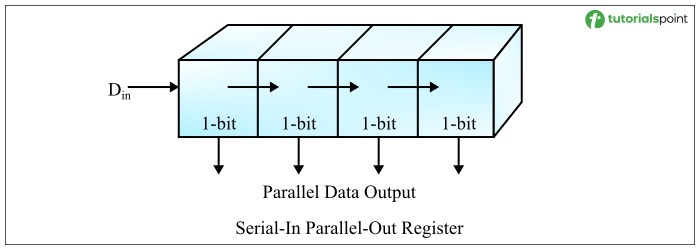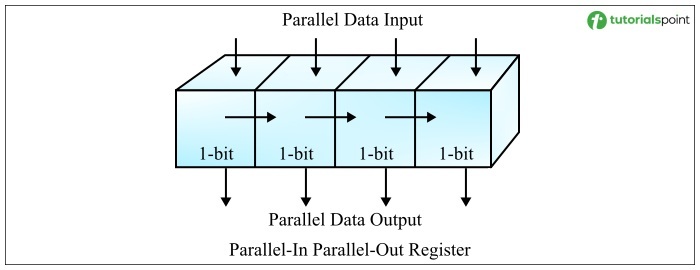
- Digital Electronics - Home
- Digital Electronics Basics
- Types of Digital Systems
- Types of Signals
- Logic Levels And Pulse Waveforms
- Digital System Components
- Digital Logic Operations
- Digital Systems Advantages
- Number Systems
- Number Systems
- Binary Numbers Representation
- Binary Arithmetic
- Signed Binary Arithmetic
- Octal Arithmetic
- Hexadecimal Arithmetic
- Complement Arithmetic
- Base Conversions
- Base Conversions
- Binary to Decimal Conversion
- Decimal to Binary Conversion
- Binary to Octal Conversion
- Octal to Binary Conversion
- Octal to Decimal Conversion
- Decimal to Octal Conversion
- Hexadecimal to Binary Conversion
- Binary to Hexadecimal Conversion
- Hexadecimal to Decimal Conversion
- Decimal to Hexadecimal Conversion
- Octal to Hexadecimal Conversion
- Hexadecimal to Octal Conversion
- Binary Codes
- Binary Codes
- 8421 BCD Code
- Excess-3 Code
- Gray Code
- ASCII Codes
- EBCDIC Code
- Code Conversion
- Error Detection & Correction Codes
- Logic Gates
- Logic Gates
- AND Gate
- OR Gate
- NOT Gate
- Universal Gates
- XOR Gate
- XNOR Gate
- CMOS Logic Gate
- OR Gate Using Diode Resistor Logic
- AND Gate vs OR Gate
- Two Level Logic Realization
- Threshold Logic
- Boolean Algebra
- Boolean Algebra
- Laws of Boolean Algebra
- Boolean Functions
- DeMorgan's Theorem
- SOP and POS Form
- POS to Standard POS Form
- Minimization Techniques
- K-Map Minimization
- Three Variable K-Map
- Four Variable K-Map
- Five Variable K-Map
- Six Variable K-Map
- Don't Care Condition
- Quine-McCluskey Method
- Min Terms and Max Terms
- Canonical and Standard Form
- Max Term Representation
- Simplification using Boolean Algebra
- Combinational Logic Circuits
- Digital Combinational Circuits
- Digital Arithmetic Circuits
- Multiplexers
- Multiplexer Design Procedure
- Mux Universal Gate
- 2-Variable Function Using 4:1 Mux
- 3-Variable Function Using 8:1 Mux
- Demultiplexers
- Mux vs Demux
- Parity Bit Generator and Checker
- Comparators
- Encoders
- Keyboard Encoders
- Priority Encoders
- Decoders
- Arithmetic Logic Unit
- 7-Segment LED Display
- Code Converters
- Code Converters
- Binary to Decimal Converter
- Decimal to BCD Converter
- BCD to Decimal Converter
- Binary to Gray Code Converter
- Gray Code to Binary Converter
- BCD to Excess-3 Converter
- Excess-3 to BCD Converter
- Adders
- Half Adders
- Full Adders
- Serial Adders
- Parallel Adders
- Full Adder using Half Adder
- Half Adder vs Full Adder
- Full Adder with NAND Gates
- Half Adder with NAND Gates
- Binary Adder-Subtractor
- Subtractors
- Half Subtractors
- Full Subtractors
- Parallel Subtractors
- Full Subtractor using 2 Half Subtractors
- Half Subtractor using NAND Gates
- Sequential Logic Circuits
- Digital Sequential Circuits
- Clock Signal and Triggering
- Latches
- Shift Registers
- Shift Register Applications
- Binary Registers
- Bidirectional Shift Register
- Counters
- Binary Counters
- Non-binary Counter
- Design of Synchronous Counter
- Synchronous vs Asynchronous Counter
- Finite State Machines
- Algorithmic State Machines
- Flip Flops
- Flip-Flops
- Conversion of Flip-Flops
- D Flip-Flops
- JK Flip-Flops
- T Flip-Flops
- SR Flip-Flops
- Clocked SR Flip-Flop
- Unclocked SR Flip-Flop
- Clocked JK Flip-Flop
- JK to T Flip-Flop
- SR to JK Flip-Flop
- Triggering Methods:Flip-Flop
- Edge-Triggered Flip-Flop
- Master-Slave JK Flip-Flop
- Race-around Condition
- A/D and D/A Converters
- Analog-to-Digital Converter
- Digital-to-Analog Converter
- DAC and ADC ICs
- Realization of Logic Gates
- NOT Gate from NAND Gate
- OR Gate from NAND Gate
- AND Gate from NAND Gate
- NOR Gate from NAND Gate
- XOR Gate from NAND Gate
- XNOR Gate from NAND Gate
- NOT Gate from NOR Gate
- OR Gate from NOR Gate
- AND Gate from NOR Gate
- NAND Gate from NOR Gate
- XOR Gate from NOR Gate
- XNOR Gate from NOR Gate
- NAND/NOR Gate using CMOS
- Full Subtractor using NAND Gate
- AND Gate Using 2:1 MUX
- OR Gate Using 2:1 MUX
- NOT Gate Using 2:1 MUX
- Memory Devices
- Memory Devices
- RAM and ROM
- Cache Memory Design
- Programmable Logic Devices
- Programmable Logic Devices
- Programmable Logic Array
- Programmable Array Logic
- Field Programmable Gate Arrays
- Digital Electronics Families
- Digital Electronics Families
- CPU Architecture
- CPU Architecture
Binary Registers in Digital Electronics
In digital electronic devices and systems, binary registers are one of the crucial components that play a vital role in data storage and manipulation. Binary registers are the fundamental building blocks in memory unit of a digital system or device.
Here, we will explore basics of binary registers and binary register data. So, lets start with the basic introduction of binary registers.
What are Binary Registers?
In digital systems, a binary register is considered the base of a data storage unit. It is a group of flip-flops connected together to store data and information in the form of 0s and 1s. The storage capacity of a binary register depends upon the number of flip-flop combined in the circuit. For example, a 4-bit binary register consists of a group of four flip-flops connected together, and is capable of storing 4-bit information.
Types of Binary Registers
Depending on the input and output configurations and data manipulation, binary registers are classified into the following four types −
Serial-In Serial-Out (SISO) Binary Register
The block diagram of a 4-bit serial-in serial-out (SISO) binary register is depicted in the following figure −

Here, the output of the first flip-flop is connected to the next flip-flop. The binary input data will enter the register through the input line Din. This entry will take place in a serial manner, i.e. first, the LSB bit will enter the register, then the following bits.
Serial-In Parallel-Out (SIPO) Binary Register
The block diagram of a 4-bit serial-in parallel-out (SIPO) binary register is depicted in the following figure.

Here, the data is entered into the register serially, and the output is taken in parallel form. In this type of binary register, while input data is being loaded, the output lines remain disabled. Once the process of data loading is completed, the output lines will become active to provide the output in parallel form.
Parallel-In Serial-Out (PISO) Binary Register
The block diagram of a 4-bit parallel-in serial-out (PISO) binary register is depicted in the following figure

This type of the binary register accepts data in parallel form and produces results serially. Therefore, in PISO binary register, all bits of the input data are loaded into the register at the same time. This register can operate in two modes namely, load mode and shift mode.
In the load mode, the input circuit becomes active to load the input data bits into the respective flip-flops of the register. In the shift mode, data bits are shifted from left to right. This results in a parallel-in serial-out operation.
Parallel-In Parallel-Out (PIPO) Binary Register
The block diagram of a 4-bit parallel-in parallel-out binary register is shown in the following figure.

This type of binary register receives data in parallel form and produces output in parallel form. Hence, in PIPO binary register, the input data bits are loaded into the respective flip-flops at the same time and the output bits will also appear at the same time.
After getting an overview of binary register and their types, let us now understand the concept of binary register data.
What is Binary Register Data?
Binary register data is nothing but the data and information stored and represented in binary form within a binary register.
In a digital system, the information is represented in the binary form, i.e. by using a string of 0s and 1s. The binary register can store these binary information in a series of flip-flops.
The sequence of input and output of the binary register data depends on the configuration of input and output lines. The amount of binary register data stored in a binary register depends on the storage capacity and number of flip-flops in the register. For example, a 16-bit binary register can store 16 binary digits of binary information.
In a binary register, the stored binary register data can be manipulating through various operations like writing, retrieving, etc. Binary registers and binary register data play an important role in any digital electronic system, such as memory devices, processors, data centers, communication systems, and more.
In digital systems like computers, calculators, etc., the binary register data are used to perform various arithmetic and logical operations.
Significance of Binary Register Data
Binary register data plays an important role in the functioning of a digit electronic system. It serves as a fundamental unit for data representation in any digital system. It makes the arithmetic and logical operations straightforward. Binary register data provides faster data manipulation which increases the data processing speed of a device.
Overall, binary register and binary register data are fundamental components of a digital system for performing operations like data storage, manipulation, retrieval, etc.
Conclusion
Binary registers provide faster and efficient storage and retrieval of binary data, making them a better choice for digital devices. Binary register data plays an important role in data storage and manipulation in digital systems. The binary register data are also used in data conversion interfaces to transform analog data into digital form. They also allow for reliable and efficient transfer of binary information between digital devices and communication networks.